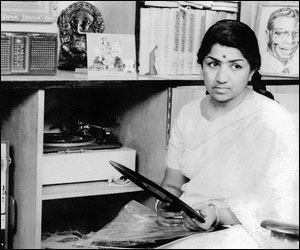

The little road where I grew up had a rather large and imposing house at one end and we didn’t interact much with the inhabitants, socially or otherwise, due to the perception that they belonged to a different strata. From time to time we would see a very personable lady come out of the house, holding the hand of a frail looking old gentleman whom she would gently guide down the front steps and assist in getting into the car. We got used to seeing this spectacle every week, along with the muted strains of “khayal” that used to spill over into our ears when we played cricket in front of the house. Along with the towering coconut tree and the little fabric printing factory that dotted our road, I assimilated the singing and the sight of the old man as mere elements of my daily life, and never felt the least bit of curiosity. It was only much later that my father in a rather admonishing tone made me aware that the “old man” was Ustad Ata Husain Khan – a doyen of Agra gharana.
My discovery of Lata Mangeshkar was through a rather similar pathway, almost like discovering that the little puddle of water at the foot of the worn down tubewell was teeming with goldfish! It took an audio cassette released by HMV to set the neurons firing on all cylinders – and suddenly I was transformed from an inanimate to a sentient being.
The year was 1989, I was studying for a career in export marketing at the Indian Institute of Foreign Trade in New Delhi. One of my batch mates, Harsh Mishra, much more advanced than me both in maturity as well as knowledge of music took a cassette called “ Lata Mangeshkar sings for Madan Mohan” during a late night session and stuck it inside the player. What followed thereafter completely engulfed me in its spell and woke me up to what I had been missing during all the years I had grown up never paying much attention to this magical source of beauty. From the very first song on the cassette, “ Woh Bhuli Daastaan lo phir yaad aa gayi”, the delicate, diaphanous texture of her voice had me in its spell, and the ease with which she wrung every last bit of emotion out of the words while tiptoeing across scales with the grace of a ballerina was a source of eternal wonder for me, and has remained so to this day. The songs in that cassette, well known to even the casual listener, convinced me that I might have just stumbled onto a lifelong obsession.
Over the next decade and a half, I went through the whole Lata-MM catalogue with a fine toothed comb. The incredible richness of melody was always tinged with a drop of melancholy, which somehow got associated with time in my mind with Lata’s voice, almost like a glowing marker. After being swept away by “ Na haso hum pe zamane ke hain thukaraaye huye” , “ Sapne me sajan se do baatein” etc. I thought I had tasted the all the vintages from this vineyard. How utterly wrong I was.
Her phenomenal work with Salil, which really needs no elaboration, is something I feel I have only scratched the surface of. The incredible range and litheness of her voice makes light of the complexity of the compositions and lays bare the inner beauty of the song for a lay listener like me. I have three words to describe this breezy partnership – Madbhari yeh hawayein..
And finally, the Burmans. Much as I am in love with her work with the Senior Burman, I am not sure that her voice with all its polish and finesse provides the ideal vehicle for a large portion of the output. I have a sneaky and completely unfounded suspicion that the Old Monk might have wished for a slightly less “taiyyaar” voice for, say, the Phagun holi song and a few others. However, with her sheer ability, of course she could breeze through and make every song her own, and she did. With Pancham she got a similar opportunity for vocal calisthenics that was provided by Salil, albeit in songs that had a vein of frivolity running through them, and we got to see a sunnier , more playful side of her in songs that would floor any singer other than her sister.
Let the music go on.
(*Krittibas Dasgupta is a devoted listener of good music, in whatever form he can get. He lives in New Zealand, with his musical antenna pointing permanently to the motherland.)
Author info is not available!